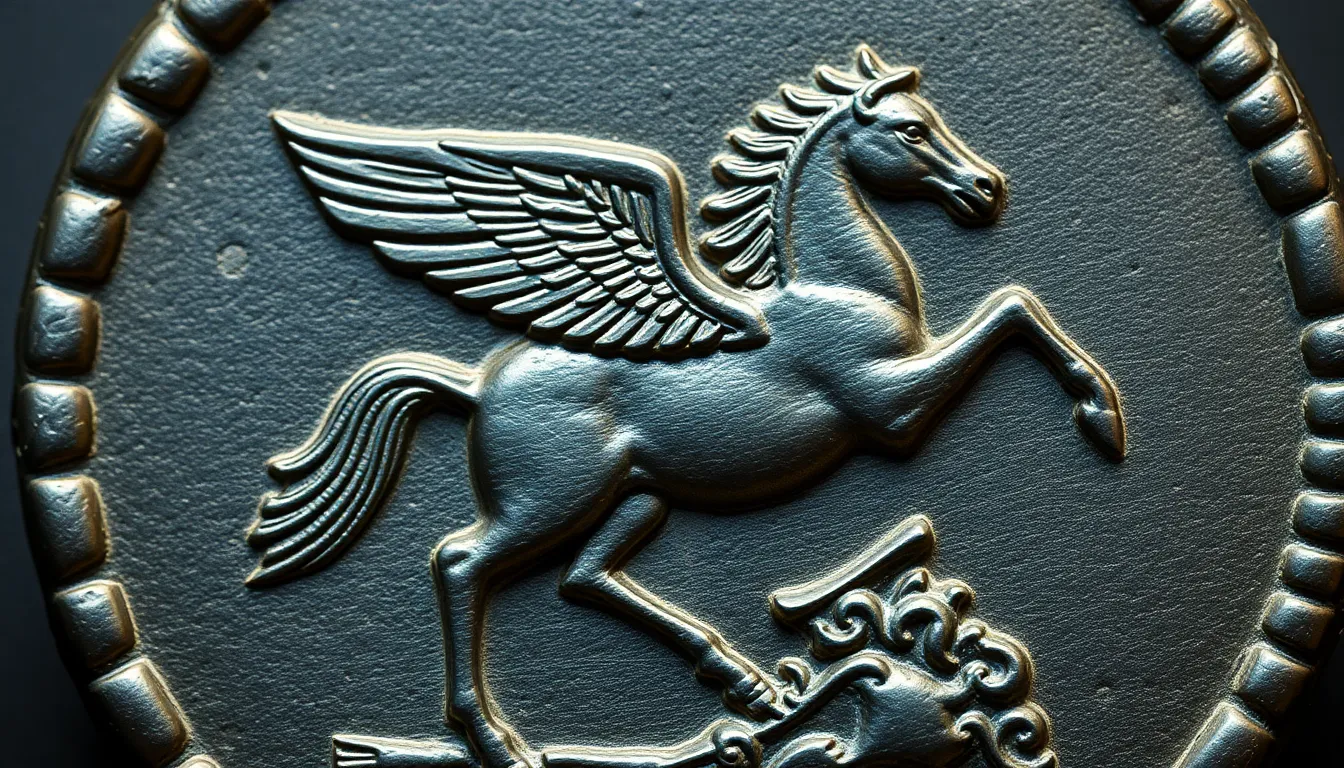Pegasus in Ancient Coins: The Winged Horse in Numismatics
I. Introduction to Numismatics and Mythological Symbols
Numismatics is the study and collection of currency, including coins, tokens, paper money, and related objects. This field encompasses various aspects, such as the history, design, and production of money, as well as the cultural and economic contexts in which it was used. Ancient coinage often carries significant mythological symbols, which serve as a window into the values, beliefs, and stories of the civilizations that produced them.
Among these symbols, Pegasus, the winged horse from Greek mythology, stands out as an important figure. As a mythological creature, Pegasus not only represents the power of flight but also embodies inspiration and creativity, making it a fitting emblem for various ancient city-states.
II. The Mythological Significance of Pegasus
Pegasus is a prominent figure in Greek mythology, originating from the blood of Medusa when she was slain by the hero Perseus. This majestic creature is often associated with the Muses, the goddesses of the arts, representing the artistic inspiration that can elevate human endeavors to divine heights.
The symbolism of Pegasus extends beyond mere flight; it embodies:
- Inspiration
- Poetic creativity
- Freedom and transcendence
Pegasus has significantly influenced ancient art, appearing in various forms, from pottery to sculptures. His image often conveyed themes of heroism and divine favor, making him a central figure in ancient narratives.
III. Historical Context of Coins Featuring Pegasus
Coins featuring Pegasus have a rich historical context that reflects the socio-political landscape of ancient Greece. The timeline of coins featuring Pegasus can be traced back to the 6th century BCE, with various city-states minting their own versions of this iconic figure.
Pegasus coins were primarily minted in regions such as:
- Corinth
- Athens
- Various city-states across Asia Minor
The depiction of Pegasus on these coins was influenced by several socio-political factors, including:
- The civic pride of city-states
- The desire to assert cultural identity
- Trade relationships with neighboring regions
IV. Notable Ancient Coins Featuring Pegasus
Several significant coins featuring Pegasus imagery have survived through the ages, each revealing a unique aspect of their respective cultures:
1. The Athenian Tetradrachm
The Athenian Tetradrachm, minted around 449 BCE, prominently features Pegasus on its reverse side. This coin symbolizes Athens’ cultural and artistic achievements and was widely used in trade.
2. Coins from Corinth
Corinth was known for its high-quality coins featuring Pegasus, particularly during the 6th century BCE. The Pegasus on these coins often appears in a more stylized form, representing wealth and power.
3. Other Notable Examples
Other examples include coins from various city-states in Asia Minor, where Pegasus appears alongside other mythological figures, showcasing local artistic styles.
These coins often possess unique characteristics, such as:
- Different artistic styles
- Variations in metal content
- Distinctive inscriptions and symbols
V. Artistic Representation of Pegasus on Coins
The artistic representation of Pegasus on coins varies widely across different cultures. Each city-state infused its own artistic flair into the design, resulting in diverse portrayals of the winged horse.
Some notable aspects of these artistic representations include:
- Variations in design, from highly detailed to more abstract forms
- Differences in style influenced by regional artistic traditions
The minting techniques used also played a crucial role in the quality and durability of these coins. Techniques such as:
- Die engraving
- Striking methods
were essential in producing coins that could withstand the test of time while showcasing intricate designs and symbolism.
VI. The Role of Pegasus in Trade and Economy
Pegasus coins played an important role in ancient trade, serving as a medium of exchange that facilitated commerce across various regions. The presence of Pegasus on these coins often signified not just value but also a shared cultural heritage among trading partners.
The influence of Pegasus coins on economic practices included:
- Standardization of trade practices
- Encouraging economic relationships and trade routes
The legacy of Pegasus coins continues to resonate in modern numismatics, where collectors and historians value them not only for their monetary worth but also for their historical and artistic significance.
VII. Collecting Pegasus Coins Today
Today, the market for Pegasus coins among collectors is robust, with enthusiasts seeking out these mythological pieces for their historical value and aesthetic appeal. Collecting Pegasus coins can be a rewarding endeavor for both novice and experienced numismatists.
For those interested in collecting, here are some tips for identifying and valuing Pegasus coins:
- Research the historical context of the coin
- Examine the coin’s condition and authenticity
- Consult with numismatic experts or reputable dealers
The appeal of mythological coins, such as those featuring Pegasus, lies in their ability to tell stories from the past, serving as tangible connections to ancient civilizations and their beliefs.
VIII. Conclusion: The Enduring Legacy of Pegasus in Numismatics
In summary, Pegasus holds a significant place in ancient coinage, symbolizing the fusion of mythology and currency. The depiction of this winged horse on coins not only highlights the artistic achievements of ancient cultures but also reflects their values and aspirations.
As we reflect on the enduring legacy of Pegasus in numismatics, it becomes clear that the study of mythological symbols on coins offers valuable insights into the interconnectedness of art, culture, and economy in the ancient world. The ongoing exploration of these themes will undoubtedly enrich our understanding of history and its impact on contemporary society.




